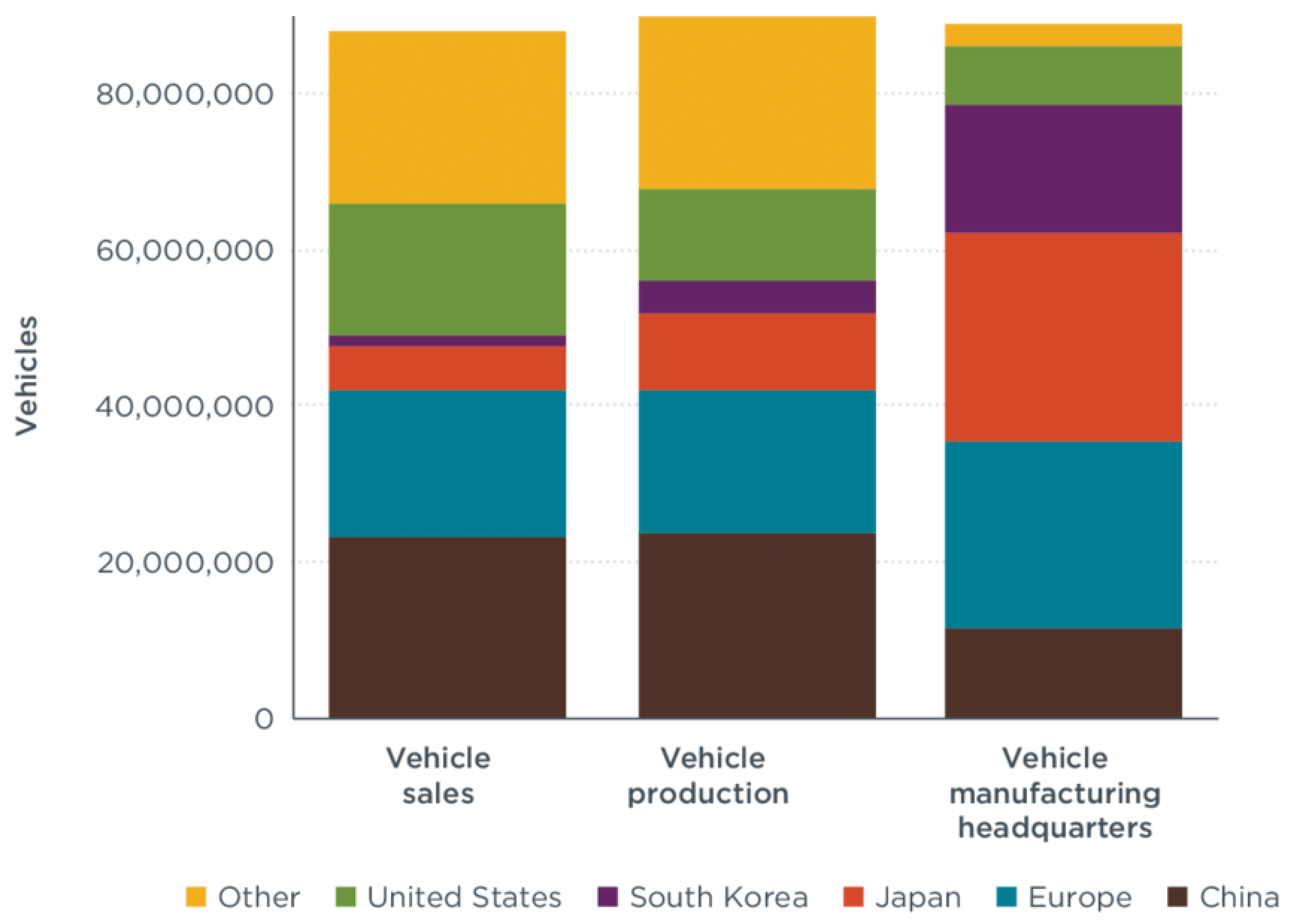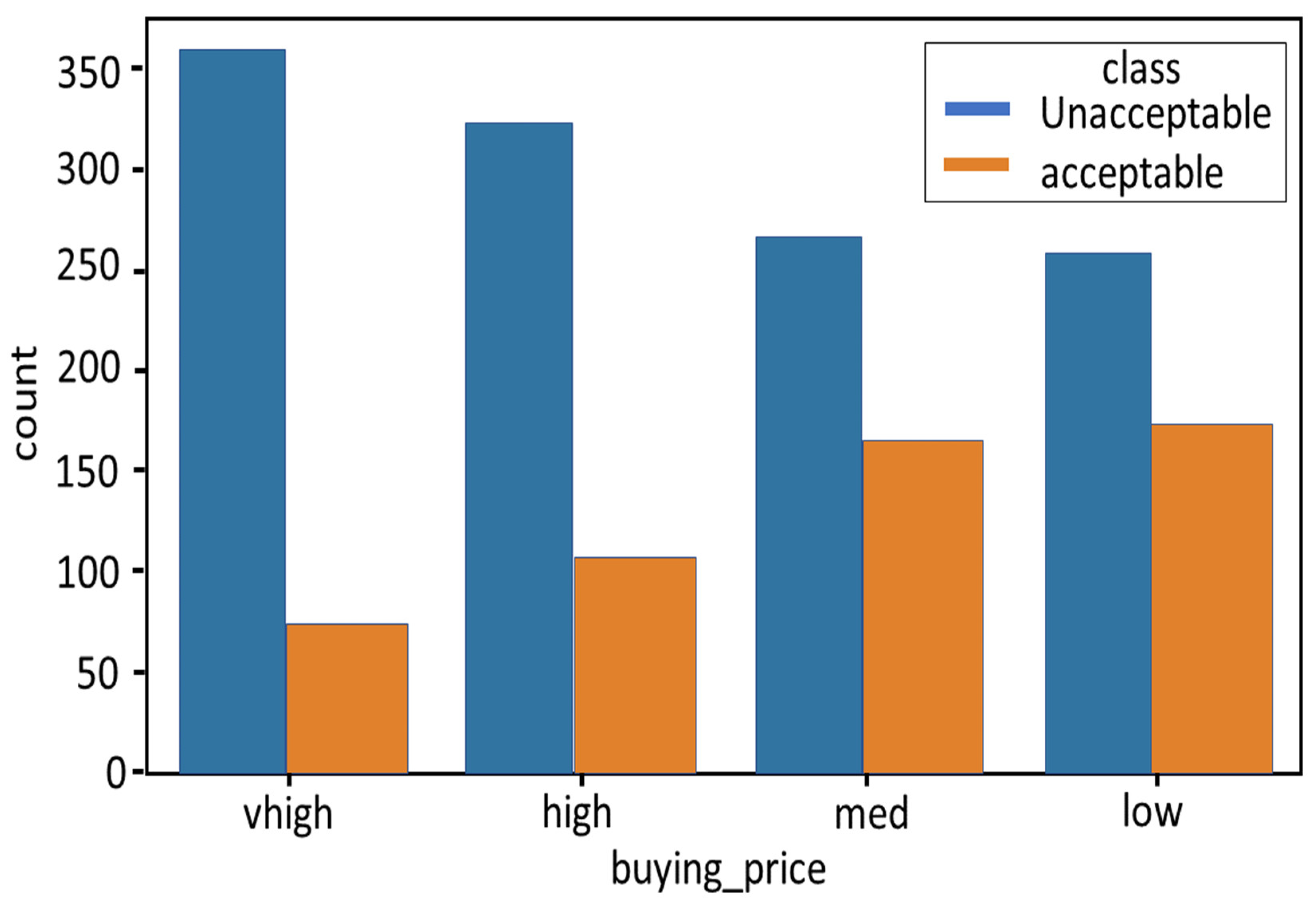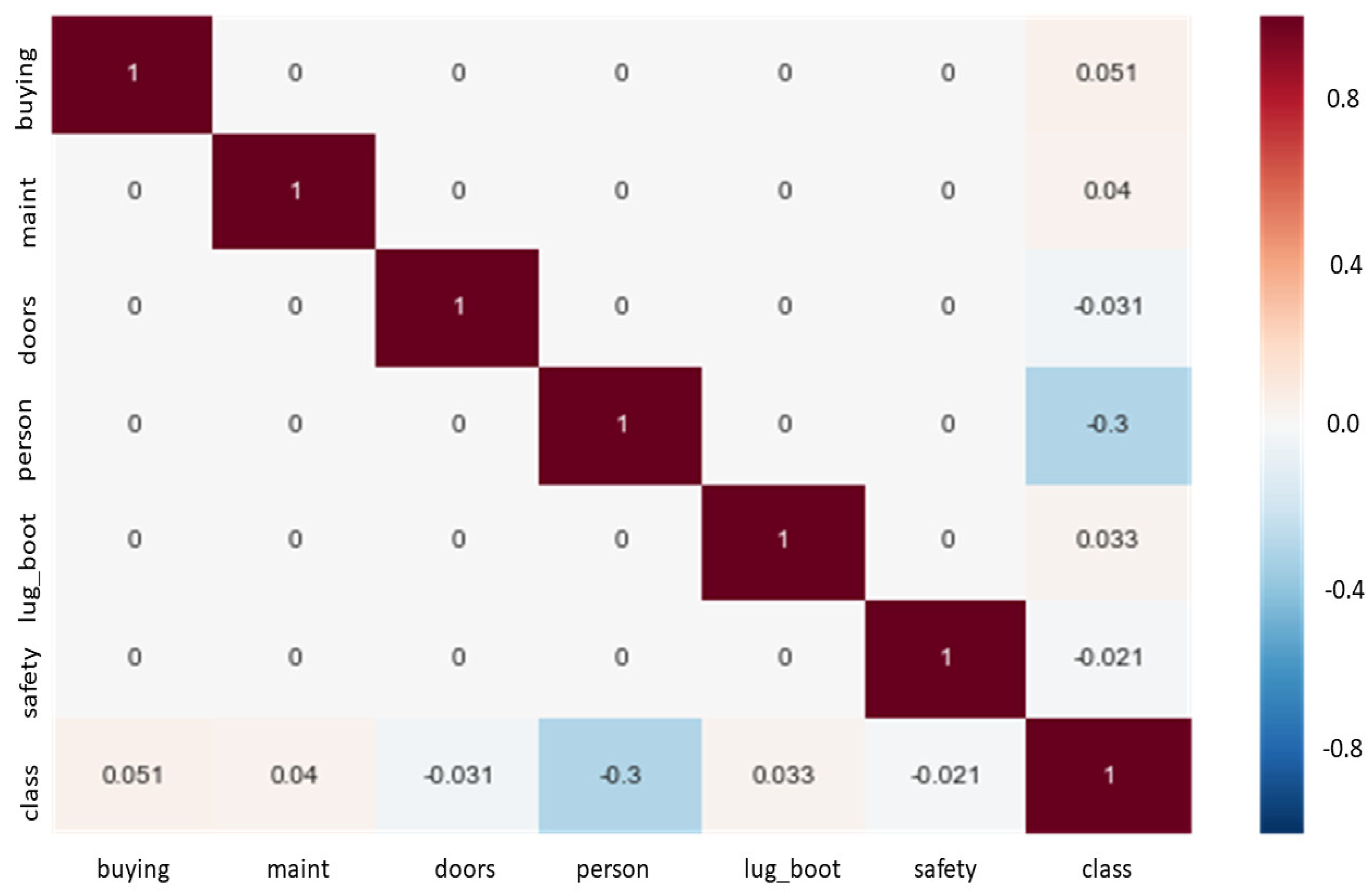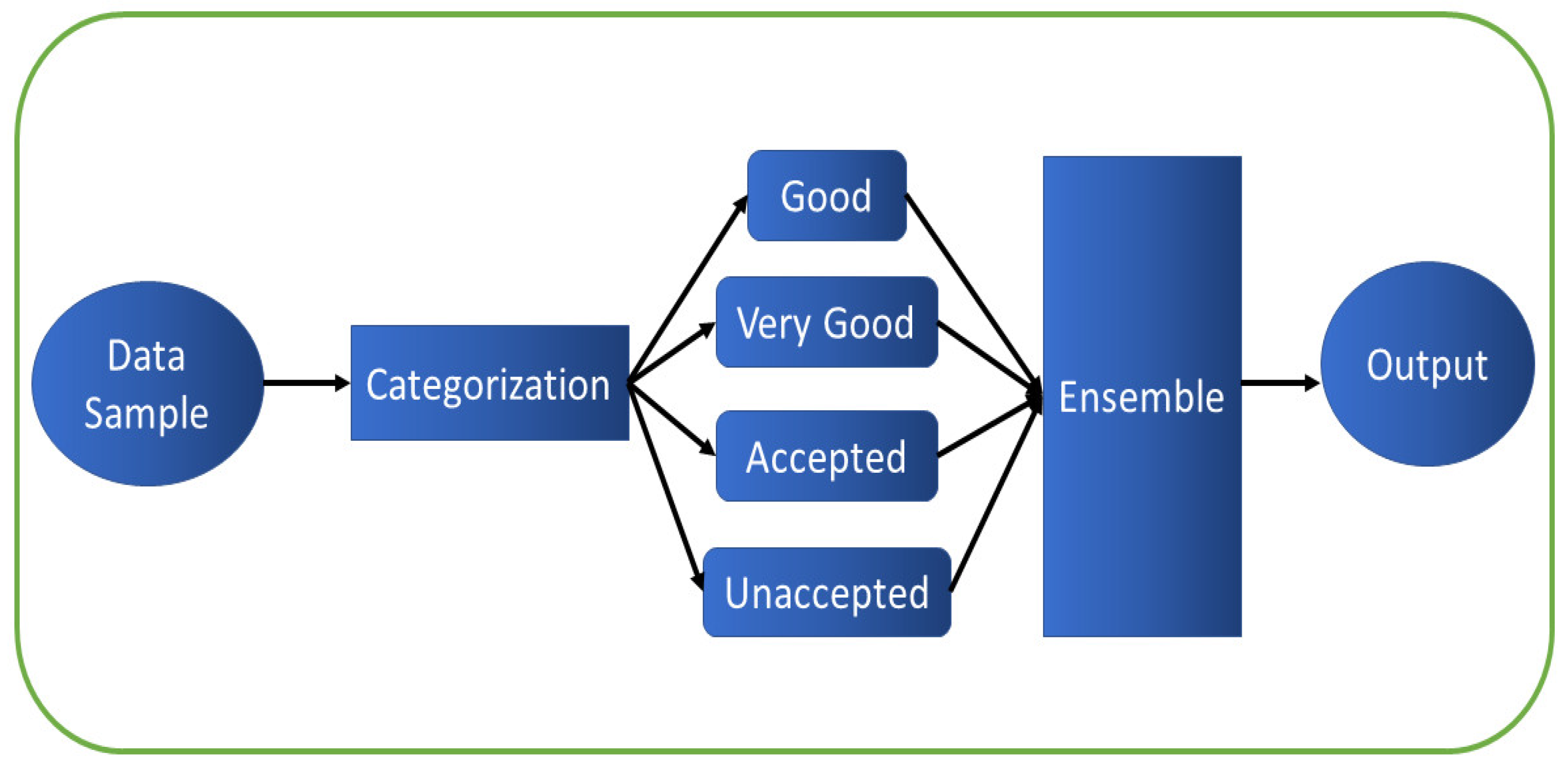Vehicle Price Classification and Prediction Using Machine Learning in the IoT Smart Manufacturing Era
Abstract
:1. Introduction
2. Literature Review
3. Methodology
- Data purifying and an assortment of notable datasets of the evaluations of car production.
- The method of ML is chosen.
- The model for vehicle prediction is obtained from the past information being handled.
- The acquired result is broken down and visualized.
3.1. Data Description
3.2. Machine Learning Method Selection
3.3. Experimental Approach
3.4. Computational Environment
4. Results
Models’ Accuracy
5. Conclusions
Author Contributions
Funding
Institutional Review Board Statement
Informed Consent Statement
Data Availability Statement
Acknowledgments
Conflicts of Interest
Abbreviations
| Terms | Meaning |
| ICT | Information and Communication Technologies |
| ODAV | Optimal Distribution of Auction Vehicles |
| ANN | Artificial Neural Network |
| MF | Matrix Factorization |
| ML | Machine Learning |
| NN | Neural Networks |
| LR | Linear Regression |
| SL | Supervised Learning |
| VS | Virtual Studio |
| SVM | Support vector machine |
References
- National Transport Authority. 2014. Available online: http://nta.gov.mu/English/Statistics/Pages/Archive.aspx (accessed on 15 January 2014).
- Yao, B.; Feng, T. Machine Learning in Automotive Industry. Adv. Mech. Eng. 2018. [Google Scholar] [CrossRef]
- Theissler, A.; Pérez-Velázquez, J.; Kettelgerdes, M.; Elger, G. Predictive maintenance enabled by machine learning: Use cases and challenges in the automotive industry. Reliab. Eng. Syst. Saf. 2021, 215, 107864. [Google Scholar] [CrossRef]
- Ali, S.E.A.; Rizvi, S.S.H.; Lai, F.; Ali, R.F.; Jan, A.A. Predicting Delinquency on Mortgage Loans: An Exhaustive Parametric Comparison of Machine Learning Techniques. Int. J. Ind. Eng. Manag. 2021, 12, 1–13. [Google Scholar]
- Zivlak, N.; Rakic, S.; Marjanovic, U.; Ciric, D.; Bogojevic, B. The Role of Digital Servitization in Transition Economy: An SNA Approach. Teh. Vjesn. 2021, 28, 1912–1919. [Google Scholar]
- Motors Mega. 2014. Available online: http://motors.mega.mu/news/2013/12/17/auto-market-8-decrease-sales-newcars/ (accessed on 17 January 2014).
- Hussain, A.A.; Bouachir, O.; Al-Turjman, F.; Aloqaily, M. AI Techniques for COVID-19. IEEE Access 2020, 8, 128776–128795. [Google Scholar] [CrossRef] [PubMed]
- Al-Turjman, F.; Nawaz, M.H.; Ulusar, U.D. Intelligence in the Internet of Medical Things era: A systematic review of current and future trends. Comput. Commun. 2019, 150, 644–660. [Google Scholar] [CrossRef]
- Milošević, M.; Živić, N.; Andjelković, I. Early churn prediction with personalized targeting in mobile social games. Expert Syst. Appl. 2017, 83, 326–332. [Google Scholar] [CrossRef]
- Monburinon, N.; Chertchom, P.; Kaewkiriya, T.; Rungpheung, S.; Buya, S.; Boonpou, P. Prediction of prices for used car by using regression models. In Proceedings of the 2018 5th International Conference on Business and Industrial Research (ICBIR), Bangkok, Thailand, 17–18 May 2018; pp. 115–119. [Google Scholar]
- Madhuvanthi, K.; Nallakaruppan, M.K.; Senthilkumar, N.C.; Siva Rama Krishnan, S. Car sales prediction using machine learning algorithms. Int. J. Innov. Technol. Explor. Eng. 2019, 8, 1039–1050. [Google Scholar]
- Hussain, A.A.; Al-Turjman, F. Resource Allocation in Volunteered Cloud Computing and Battling COVID-19; CRC Press: Boca Raton, FL, USA, 2020. [Google Scholar] [CrossRef]
- Singh, Y.; Bhatia, P.K.; Sangwan, O. A review of studies on machine learning techniques. Int. J. Comput. Sci. Secur. 2007, 1, 70–84. [Google Scholar]
- Agencija Za Statistiku BiH. (n.d.). Available online: http://www.bhas.ba (accessed on 18 July 2018).
- Ahmed Hussain, A.; Dimililer, K. Student Grade Prediction Using Machine Learning in Iot Era. In Proceedings of the Forthcoming Networks and Sustainability in the IoT Era, First EAI International Conference, FoNeS—IoT 2020, Virtual Event, 1–2 October 2020. [Google Scholar]
- Ullah, Z.; Al-Turjman, F.; Mostarda, L.; Gagliardi, R. Applications of Artificial Intelligence And Machine Learning in Smart Cities. Elsevier Comput. Commun. J. 2020, 154, 313–323. [Google Scholar] [CrossRef]
- Al-Turjman, F.; Baali, I. Machine Learning for Wearable IoT-based Applications: A Survey. Trans. Emerg. Telecommun. Technol. 2019, e3635. [Google Scholar] [CrossRef]
- Lutsey, N. Transition to a Global Zero-Emission Vehicle Fleet: A Collaborative Agenda for Governments. 2015. Available online: https://theicct.org/sites/default/files/publications/ICCT_GlobalZEVAlliance_201509.pdf (accessed on 24 March 2022).
- Wu, J.D.; Hsu, C.C.; Chen, H.C. An expert system of price forecasting for used cars using adaptive neuro-fuzzy inference. Expert Syst. Appl. 2009, 36, 7809–7817. [Google Scholar] [CrossRef]
- Jin, J.; Sun, W.; Al-Turjman, F.; Khan, M.; Yang, X. Activity Pattern Mining for Healthcare. IEEE Access 2020, 8, 56730–56738. [Google Scholar] [CrossRef]
- Du, J.; Xie, L.; Schroeder, S. Practice Prize Paper—PIN Optimal Distribution of Auction Vehicles System: Applying Price Forecasting, Elasticity Estimation and Genetic Algorithms to Used-Vehicle Distribution. Mark. Sci. 2009, 28, 637–644. [Google Scholar] [CrossRef]
- Al-Turjman, F.; Lemayian, J. Intelligence, Security, and Vehicular Sensor Networks in Internet of Things (IoT)-enabled Smart-cities: An Overview. Elsevier Comput. Electr. Eng. J. 2020, 87, 106776. [Google Scholar] [CrossRef]
- Bohanec, M.; Borštnar, M.K.; Robnik-Šikonja, M. Explaining machine learning models in sales predictions. Expert Syst. Appl. 2017, 71, 416–428. [Google Scholar] [CrossRef]
- Safar, A.; Safar, M. Intelligent Flower Detection System Using Machine Learning. In Advances in Intelligent Systems and Computing; Intelligent Systems and Applications; IntelliSys 2019; Bi, Y., Bhatia, R., Kapoor, S., Eds.; Springer: Cham, Switzerland, 2020; Volume 1038. [Google Scholar] [CrossRef]
- Gonggi, S. New model for residual value prediction of used cars based on BP neural network and non-linear curve fit. In Proceedings of the 3rd IEEE International Conference on Measuring Technology and Mechatronics Automation (ICMTMA), Shanghai, China, 6–7 January 2011; IEEE Computer Society: Washington, DC, USA, 2011; Volume 2, pp. 682–685. [Google Scholar]
- Pudaruth, S. Predicting the price of used cars using machine learning techniques. Int. J. Inf. Comput. Technol. 2014, 4, 753–764. [Google Scholar]
- Al-Turjman, F.; Malekoo, A. Smart Parking in IoT-enabled Cities: A Survey. Elsevier Sustain. Cities Soc. 2019, 49, 101608. [Google Scholar] [CrossRef]
- Noor, K.; Jan, S. Vehicle Price Prediction System using Machine Learning Techniques. Int. J. Comput. Appl. 2017, 167, 27–31. [Google Scholar] [CrossRef]
- Dua, D.; Graff, C. UCI Machine Learning Repository; University of California, School of Information and Computer Science: Irvine, CA, USA, 2019; Available online: http://archive.ics.uci.edu/ml (accessed on 24 March 2022).
- Samruddhi, K.; Ashok Kumar, R. Used Car Price Prediction using K-Nearest Neighbor Based Model. Int. J. Innov. Res. Appl. Sci. Eng. 2020, 4, 686–689. [Google Scholar] [CrossRef]





| Number | Buying | Maintenance | Door | Persons | Luggage Boot | Class |
|---|---|---|---|---|---|---|
| 0 | Very High | Very High | 2 | 2 | Small | Unacceptable |
| 1 | Very High | Very High | 2 | 2 | Small | Unacceptable |
| 2 | Very High | Very High | 2 | 2 | Small | Unacceptable |
| 3 | Very High | Very High | 2 | 3 | Medium | Unacceptable |
| 4 | Very High | Very High | 2 | 2 | Medium | Unacceptable |
| Models | Accuracy (%) | Error (%) |
|---|---|---|
| LR | 0.41 | 0.8 |
| SVM | 0.49 | 0.10 |
| DT | 0.45 | 0.6 |
| NN | 0.42 | 0.7 |
| Models | LR | SVM | DT | NN |
|---|---|---|---|---|
| Good/90% split | 0.81 | 0.86 | 0.85 | 0.83 |
| 10-fold cross-validation | 0.79 | 0.86 | 0.86 | 0.81 |
| Very Good/90% split | 0.82 | 0.83 | 0.82 | 0.86 |
| 10-fold cross-validation | 0.76 | 0.78 | 0.75 | 0.79 |
| Accepted/90% split | 0.84 | 0.90 | 0.88 | 0.85 |
| 10-fold cross-validation | 0.77 | 0.79 | 0.78 | 0.78 |
| Unaccepted/90% split | 0.84 | 0.88 | 0.85 | 0.85 |
| 10-fold cross-validation | 0.78 | 0.82 | 0.81 | 0.81 |
Publisher’s Note: MDPI stays neutral with regard to jurisdictional claims in published maps and institutional affiliations. |
© 2022 by the authors. Licensee MDPI, Basel, Switzerland. This article is an open access article distributed under the terms and conditions of the Creative Commons Attribution (CC BY) license (https://creativecommons.org/licenses/by/4.0/).
Share and Cite
Al-Turjman, F.; Hussain, A.A.; Alturjman, S.; Altrjman, C. Vehicle Price Classification and Prediction Using Machine Learning in the IoT Smart Manufacturing Era. Sustainability 2022, 14, 9147. https://doi.org/10.3390/su14159147
Al-Turjman F, Hussain AA, Alturjman S, Altrjman C. Vehicle Price Classification and Prediction Using Machine Learning in the IoT Smart Manufacturing Era. Sustainability. 2022; 14(15):9147. https://doi.org/10.3390/su14159147
Chicago/Turabian StyleAl-Turjman, Fadi, Adedoyin A. Hussain, Sinem Alturjman, and Chadi Altrjman. 2022. "Vehicle Price Classification and Prediction Using Machine Learning in the IoT Smart Manufacturing Era" Sustainability 14, no. 15: 9147. https://doi.org/10.3390/su14159147
APA StyleAl-Turjman, F., Hussain, A. A., Alturjman, S., & Altrjman, C. (2022). Vehicle Price Classification and Prediction Using Machine Learning in the IoT Smart Manufacturing Era. Sustainability, 14(15), 9147. https://doi.org/10.3390/su14159147







